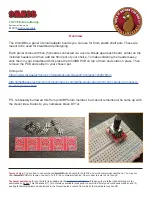
Section 10- Protein BCA
10. Protein BCA
The BCA (Bicinchoninic Acid) Protein Assay is an alternative method for determining protein concentration. It is often used for more
dilute protein solutions and/or in the presence of components that also have significant UV (280 nm) absorbance. Unlike the Protein
A280 method, the BCA Assay requires a standard curve to be generated each time it is run, before unknown proteins can be measured.
The resulting Cu-BCA chelate formed in the presence of protein is measured at its wavelength maximum of 562 nm and normalized at
750 nm. Pre-formulated reagents of BCA and CuSO
4
, utilized in the assay, are available in kit form from numerous manufacturers.
Follow their recommendations when mixing the respective reagents at the time the assay is to be performed.
Sample Volume Requirements
Some proteins are hydrophobic and others hydrophilic giving rise to variable surface tension in the sample to be measured. Additionally
the presence of surfactants or detergents in reagents, such as the Bradford reagent, can significantly alter surface tension. This
occurrence can be overcome without affecting the sample’s absorbance by using a larger sample volume.
A 2 ul sample size is
recommended for protein measurements
.
Special Cleaning Requirements for Proteins
Proteins and solutions containing surfactants are known to “un-condition” the measurement pedestal surfaces so that the liquid column
does not form. If this occurs, “buff” the measurement pedestal surfaces by rubbing each with a dry laboratory wipe 15-20 times. This
will “re-condition” the surface allowing for the liquid sample column to form.
Measurement Concentration Range
On the NanoDrop
®
ND-1000 Spectrophotometer, the regular BCA assay can measure samples from ~0.20 mg/ml up to 8.0 mg/ml. A
mini-BCA assay covers an approximate range of 0.01 – 0.20 mg/ml.
Assay
Type
Approx.
Lower
Limit
Approx.
Upper
Limit
Typical Reproducibility
(minimum 5 replicates)
(SD= mg/ml; CV= %)
Regular BCA
0.2 mg/ml
8.0 mg/ml
±
2% (over entire range)
Mini BCA
0.01 mg/ml
0.20 mg/ml
±
0.01 mg/ml (over entire range)
BCA Kits, Protocols, and Sample Preparation
Commercial BCA Protein kit manufacturers typically outline procedures for two different protein concentration ranges:
•
A regular assay – using a 20:1 reagent / sample volume ratio. To accurately prepare standards, we suggest using a minimum
sample volume of 4 ul in 80 ul of BCA reagent (larger sample volume is preferable).
•
A mini assay – using a 1:1 reagent / sample volume ratio. To prepare sufficient volume of these 1:1 mixtures, we suggest
using a minimum of 10 ul of sample and 10 ul of BCA reagent in a PCR tube. Using the same pipettor for both volumes will
eliminate any pipette-to-pipette accuracy differences.
Note: If you run the assay at 60
°
C, doubling the volumes may afford greater insurance against skewed results from
evaporation / condensation within the sealed reaction tube.
In addition to the kit reagents, protein standards (BSA) for generating a standard curve are provided for the BCA method by the
manufacturer. Follow the manufacturer’s protocol for the assay including recommended incubation times and temperature. Additionally,
use the respective standard (e.g., BSA) and dilutions that cover the analytical range (mg/ml) of interest. Note: Since the ND-1000 can
measure higher protein concentrations, you may need to supply your own protein standards at higher concentrations than provided by
the manufacturer.
Unique Screen Features
View Standard Curve (F8):
selecting this button allows the user to view the standard curve at any time.
Sample Type:
choices are Reference, Standards 1-7, and Sample. The software will guide you to measure your reference, then at
least one standard before allowing measurement of samples.
Replicate #:
counter for tracking replicate number during reference and standard measurement.
Reset Window (F11):
clears all replicates of all standards.
Reset This Std (F12):
clears all replicates of the selected standard.
Absorbance at 562nm:
the Cu-BCA complex’s absorbance at 562 nm for the 1mm pathlength.
Cursor
λ
and Absorbance:
this feature allows the user to adjust the cursor wavelength and view the corresponding absorbance. The
cursor wavelength can be set by the user. Note: The user-selected wavelength and absorbance are not utilized in any calculations.
10-1
















































